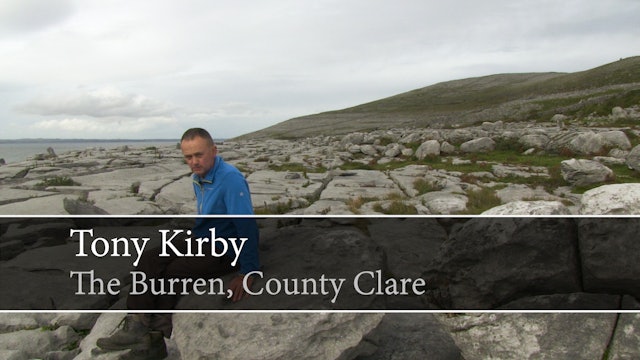Trek Ireland in the Burren, County Clare
Explore the Burren, County Clare with local guide Tony Kirby from Heart of Burren Walks
https://www.heartofburrenwalks.com/
Climb the rocky slopes of Mullaghmore to an ancient Irish ancestral tomb from 4,500 BC.
Walk on an ancient Irish cattle highway where unique farming traditions dating back thousands of years are still practiced here today.
Discover Alpine, Arctic, and Mediterranean wildflowers flourishing side-by-side as you explore native Irish hazel and ash woodland.
Take an Early Christian Irish pilgrimmage to the Hermitage of Saint Colman Mac Duagh where an Abbot lived in prayer and solitude.
Duration: 3 hours 5 minutes
Guided Virtual Tour Series Highlights: Native Irish Mature Hazel Ash Woodland, Geological Mountain Range, Natural Karst Limestone Pavement, Early Christian Irish Hermitage, Alpine, Arctic, and Mediterranean Wildflowers, Ancient Prehistoric Irish Archaeology, Irish History and Local Heritage
International monetary donations (IMDS) accepted at each guided virtual tour
-
Local Guide Tony Kirby, The Burren, County Clare
Local Guide: Tony Kirby, Heart of Burren Walks
https://www.heartofburrenwalks.com/ -
Guided Virtual Walking Tour Black Head, Fanore, County Clare
Location: Black Head, Fanore, County Clare, Ireland
Local guide: Tony Kirby, Heart of Burren Walks https://www.heartofburrenwalks.com/Guided Virtual Tour Highlights: Green Road / Ancient Irish Cattle Highway, Natural Karst Limestone Pavement, Magnificent Views of Galway Bay, Maamturks of Connem...
-
Guided Virtual Walking Tour Mullaghmore, Glenquin, County Clare
Location: Mullaghmore, Glenquin, County Clare, Ireland
Local guide: Tony Kirby, Heart of Burren Walks, https://www.heartofburrenwalks.com/Guided Virtual Tour Highlights: 1840s Famine Relief Road & Quarry, Natural Karst Limestone Pavement, Admixture of Alpine, Arctic, and Mediterranean Wildflowe...
-
Guided Virtual Walking Tour Gortlecka, Knockaunroe, County Clare
Location: Gortlecka, Knockaunroe, County Clare, Ireland
Local Guide: Tony Kirby, Heart of Burren Walks https://www.heartofburrenwalks.com/Guided Virtual Tour Highlights: Native Irish Mature Hazel-Ash Woodland, Admixture of Alpine, Arctic, and Mediterranean Wildflowers, Natural Karst Limestone P...
-
Guided Virtual Walking Tour Saint Colman MacDuagh, Keelhilla, County Clare
Location: Hermitage of St Colman MacDuagh, Keelhilla, County Clare, Ireland
Local guide: Tony Kirby, Heart of Burren Walks https://www.heartofburrenwalks.com/Guided Virtual Tour Highlights: Burren National Park, Slieve Carron Nature Reserve, Glacial Esker, Woodland Scrub, Early Christian Irish ...
-
Scenic Viewpoint Corcomroe Abbey, Bell Harbour, County Clare
Location: Corcomroe Abbey, Bell Harbour, County Clare, Ireland
Scenic Viewpoint: Corcomroe Abbey, or 'St. Mary of the Fertile Rock', is said to have been built by Donal Mór Ua Briain, late in the 12th century, and remained in continuous habitation by Cistercian monks until the mid-17th century AD... -
Scenic Viewpoint Knockanes, Knockanes Lower, County Clare
Location: Knockanes, Knockanes Lower, County Clare, Ireland
Scenic Viewpoint: Enjoy the horse shoe shaped Knockanes Mountain while sat among Early Spring wildflowers in bloom. -
Scenic Viewpoint Gleninagh Castle, Gleninagh, County Clare
Location: Gleninagh Castle, Gleninagh, County Clare, Ireland
Scenic Viewpoint: Gleninagh Castle was the stronghold of the O'Loughlin family, who owned and lived in this castle from the 16th Century up until 1840AD. The distinctive L-shape of the castle allowed the main entrance to be defended by ... -
Scenic Viewpopint Poll na Brón, Poulnabrone, County Clare
Location: Poll na Brón, Poulnabrone, County Clare, Ireland
Scenic Viewpoint: Poll na Brón (Hole of the Sorrows) is a Irish Neolithic Dolmen, dating to approximately 4,000 BC. It is a gravestone to our great ancestors.










